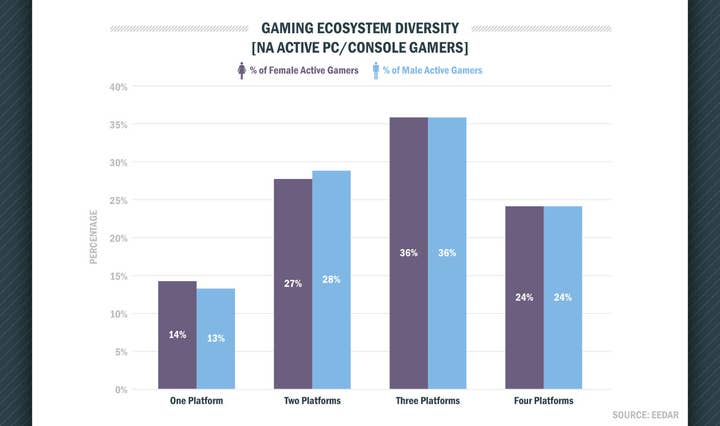Platform, not gender, drives gamer differences - EEDAR
Dr. Heather Nofziger, EEDAR's head of survey research, offers some perspective on common misperceptions about gender
Historically, video games have been marketed primarily to male players - but gaming has never been a monolithic entity. The vibrancy and variety of experiences offered by the global industry is one of its greatest strengths, and it's been on a trajectory towards more diversity - and not less - for some time now.
Tracing the development of the industry, it becomes clear that this diversity has largely been driven by the evolution of hardware and the introduction of new platforms that allow for unique experiences. From PC to consoles and designated handhelds, from the family-friendly Wii to smartphones and tablets; each of these has given rise to unique gameplay and allowed players to fit video games into their lives in new ways.
Recently, the rapid rise of mobile gaming and smart devices has made it tempting to argue that this increased diversification has compromised the traditional gaming experience. From this perspective, recent industry trends have reflected a perceived 'casualization' of gaming, as match-3 puzzle players are being lumped in with traditional gamers. Although the mobile platform has certainly been uniquely capable of attracting a wide market (it is easily the most accessible and welcoming platform on the market - requiring devices that people probably already own and offering the greatest variety of play options), the popularity of smartphones/tablets as gaming devices has hardly been driven by new players alone.
"This data suggests that, far from being a threat, the trend towards diversity is to the industry's overall benefit. It reflects the expansion into new markets, bringing gaming to wider audiences"
If we look at the broader market, we find that much of this growth has actually taken place among existing gamers. Looking specifically at the most "traditional" gamers - core PC and console gamers - we find that the vast majority (86%) are actively gaming across multiple platforms (PC, console, handheld, mobile), and of these, most (75%) are incorporating mobile as one of those platforms. This suggests that, far from detracting from traditional gaming, these new options supplement and enhance the overall experience by allowing them to incorporate gaming into more areas of their daily lives.
Understanding heavy overlap in player-ship across platforms is only part of the issue, however, and the question still remains as to how the more diverse population of players impacts the popular perception of the gamer identity. Traditionally, it was held that male and female players acted and gamed in significantly different ways, with men gravitating to more core gaming experiences while women leaned more towards casual ones.
But in reality, this perception appears to be far from accurate - active gamers (whether they are male or female) are engaging with video games in largely the same manner. This is not to say that all men and women are gaming identically, but that the overarching pattern and their average level of investment do not differ significantly. The truly significant differences, rather, emerge along platform lines.

Gamers seek out those experiences that best suit the amount of investment they are willing or able to put forth at a given time. As a result, those who seek lower investment games tend to play on mobile platforms, while those who have more time and/or money to invest look for handheld or console experiences. This is not to suggest that gamers are tied to a single experience, however - remember that most (86%) are engaging in varied experiences across multiple platforms. In this way most gamers are balancing several options, and gravitate towards that which best suits their needs at a given time.

It should be noted that for the purpose of this analysis, PC gaming was not separately segmented largely because it is difficult to obtain data that accurately represents the full breadth of the PC gaming experience - considering that the possibilities range from hyper-casual card games and browser-based social games, to Shooters and RPGs, and the hyper-core MMORPGs, and MOBAs. To provide some context for PC gaming, an examination of core PC (e.g. Steam) gamers suggests that the market is still largely male (65%), with male gamers tending to be slightly heavier players/payers than females (58% of men are heavy players/payers, compared to 40% of women). Despite this difference in investment, there is a heavy degree of overlap in genre preferences - with RPGs, MMORPGs and Strategy games being among players' top five genres.
Taken together, this data suggests that, far from being a threat, the trend towards diversity is to the industry's overall benefit. It reflects the expansion into new markets, bringing gaming to wider audiences and allowing gamers to add new experiences to their repertoire. Furthermore, any schism between how gamers play is largely driven by the platforms they use, and the game experiences offered on them, and not the gender of the players.
With this in mind, the market is certainly open to continued growth. The new platforms and experiences are not supplanting traditional gaming. Instead, they are adding to it by providing gamers (both new and seasoned) with broader opportunities to incorporate gaming into more parts of their lives. As long as games continue to fulfill their varied roles across different platforms, gamers will seek them out just as they have over the past 30 years.
